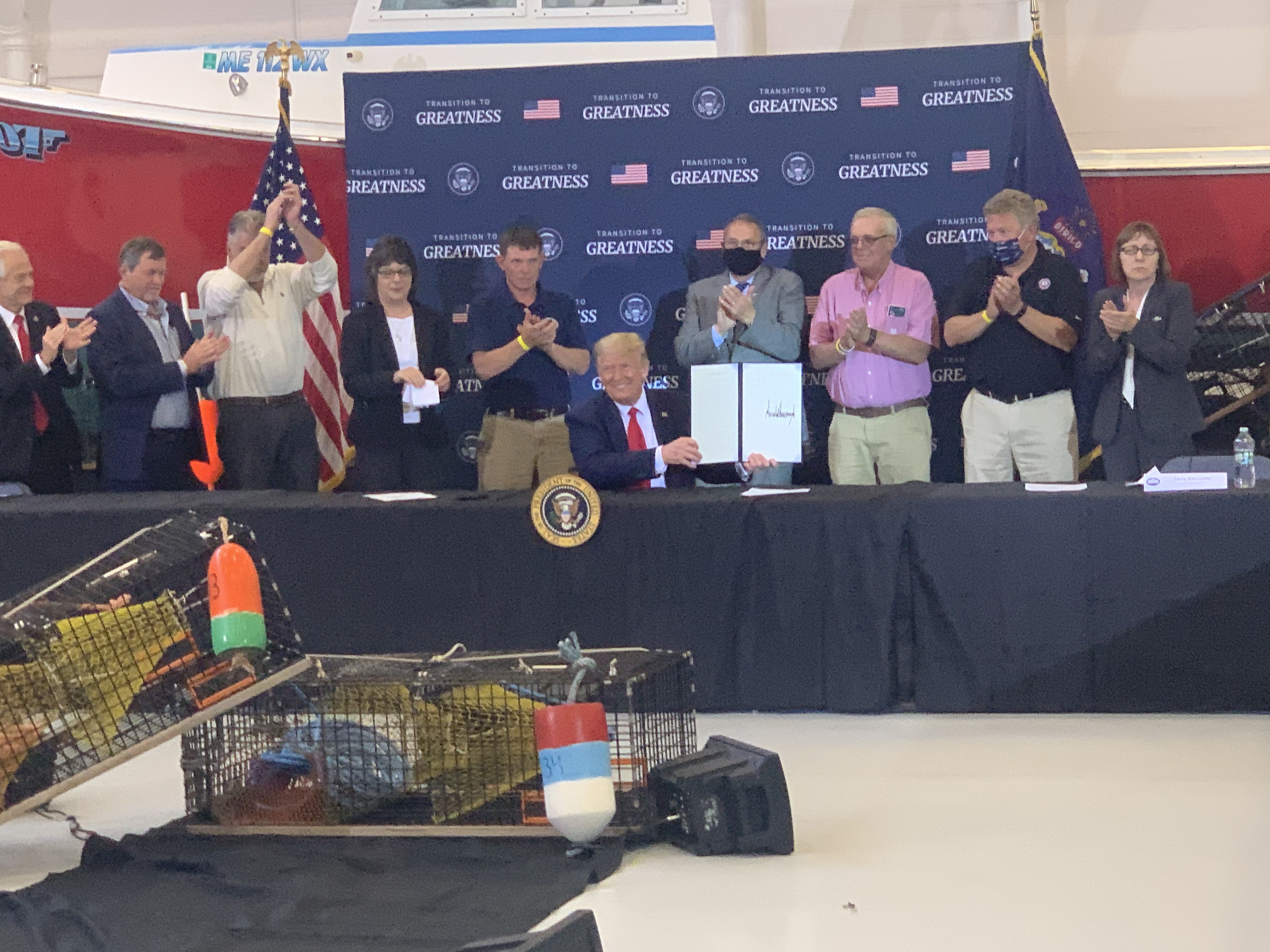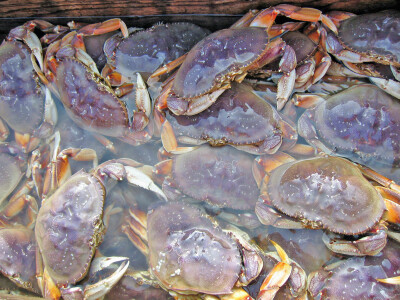Presidential proclamation and roundtable highlight the complexities of our essential and often overlooked American fishing industry
President Donald Trump brought a national spotlight to fisheries with a visit to Maine in early June. The event was promoted as a roundtable discussion of fisheries issues with commercial fishing and seafood leaders from the state, culminating in the president’s signing a proclamation to allow commercial fishing in an Atlantic marine monument.
The importance of industry participation and input was a point most panelists tried to drive home in their comments.
“Fishermen need to have the input into this, and we didn’t,” said Kristan Porter, a panelist and president of the Maine Lobstermen’s Association, referring to the Obama administration’s declaration of the Northeast Canyons and Seamounts Marine National Monument in 2016.

“We really worry about the precedent it sets, that you can close large areas of ocean and put all the rest of us who fish for different things in smaller and smaller boxes,” Porter added. “And that hurts everybody.”
The legal validity of the president’s proclamation to reopen the monument to commercial fishing (it has remained open to recreational fishing) is in question, as the move is unprecedented. In fact, by mid-June, the Conservation Law Foundation and Center for Biological Diversity had filed a legal challenge to the president’s authority to erase the protections President Barack Obama established with the monument in 2016, shortly before leaving office.
Marine monuments themselves have been subjected to legal tests of the Antiquities Act, under which they’re created. The act was passed in 1906 to give the president authority to protect historic and scientific landmarks on lands owned by the federal government. Its extension into federal waters was first tested 100 years later under President George W. Bush when he created the first Pacific monument in 2006. Challenges to the Atlantic monument have been dismissed in federal district court and through the appeals process.
Support for corrective measures on this monument came from all corners of the industry as stakeholders responded to the roundtable event.
“The National Fisheries Institute applauds the Trump administration for withdrawing arbitrary fisheries restrictions on the Northeast Canyons and Seamounts National Monument off the coast of New England,” the organization said in a release. “We welcome efforts to refocus on fisheries regulation that are transparent, participatory and science-based, and in this case best achieved through the New England Fishery Management Council.”
The panelists at the roundtable also declared their support for returning the management of the monument area to the New England Fishery Management Council, which had jurisdiction and had extended habitat protection measures and fishing restrictions from 2002 until the monument declaration.
“I’ve been involved in these fisheries for 50 years off New England, both as a captain and as a vessel and fleet owner,” said James Odlin, former groundfish fisherman, three-term New England council member and NF Highliner. “And I served on the council for nine years, helping to make some of these regulations. I worked on the Habitat Committee issues, where we worked for many years, and then we were ready to roll. And all of a sudden, we get this order that said, ‘Your work doesn’t matter. We’re closing 5,000 whole square miles.’”

Most of those in attendance would not personally benefit from a reopening of the area to commercial fisheries. Their objection to the monument, they said in their comments, is based on the precedent it set by excluding stakeholders from the public process of marine management.
“The management of fisheries within our Exclusive Economic Zone is rightfully managed under the Magnuson Stevens [Fishery] Conservation and Management Act, so we have a process to do that,” said Maggie Raymond, executive director of the Associated Fisheries of Maine. “We don’t need the Antiquities Act to be establishing monuments that restrict fishing.”
This proclamation follows on the heels of the president’s executive order issued in May. His opening remarks referred to that order, which included a review of federal fisheries laws, the creation of a seafood trade task force and a clamp down on illegally harvested seafood.

Panelists called attention to other hot-button federal fisheries issues like whale interactions, observers and stock status. However, the president centered the conversation on the monument, the effects of his administration’s trade war with China and his repeated desire to escalate a trade war with the EU.
“I heard that Canada doesn’t have to pay a tariff going into Europe, but you do?” Trump asked the panel. “OK, so if that goes on, then we’re gonna do something that’s gonna make that look like small time.”
“Two years ago we were sending a lot of product to China,” said panelist and former Maine Gov. Paul LePage. “And then China put a tariff on us of 40 percent because of some of the trade issues between the two countries.”
“And what happened to the tariff? Is it on now?” Trump asked, seemingly unaware of the status of his administration’s trade policy.
“Oh, it’s not gone down,” LePage said. “I haven’t checked lately, but you’re still paying the tariffs, right?” he asked the panel.
The Chinese tariffs are the latest escalation in a trade war that started when the Trump administration levied tariffs on $250 billion in Chinese imports in 2018 in an attempt to bring China’s leaders to the negotiating table.
“On June 1, 2018, the Maine Lobster Dealers’ Association held a meeting with the Office of the U.S. Trade Representative in Portland, Maine,” said Annie Tselikis, executive director of the Maine Lobster Dealers’ Association in a response to the roundtable. “We were reading the writing on the wall with the evolving U.S.-China trade war, as several agricultural commodities had been listed in the tit-for-tat, and thought it prudent to also discuss the importance of the China market for U.S. exporters. Two weeks later, China instituted a 25 percent retaliatory tariff on lobster exports from the USA along with 200 other American seafood products. Our industry became a casualty in a trade war.”
At the roundtable discussion, Trump used the Chinese tariffs as a springboard for his evolving EU trade platform.
“You’re saying China charges a 40 percent tariff, and how big is the tariff that the European Union charges?” Trump asked LePage.
“Twenty, it’s 20 or 22,” LePage replied.
“The EU assesses an 8 percent tariff on live lobster and a 16-20 percent tariff on processed and frozen lobster products exported from the USA,” Tselikis added in her response. “Those tariffs exist because the U.S. failed to complete the Transatlantic Trade and Investment Partnership with the EU. TTIP negotiations started in 2013 and were halted in 2019. The reason Canada exports lobsters without a tariff is because they negotiated and completed the Comprehensive Economic Trade Agreement.”
At the roundtable, Trump addressed the press directly on the topic: “If European Union doesn’t drop that tariff immediately, we’re gonna put a tariff on their cars, which will be equivalent coming in... it’s going to be the equivalent-plus... watch how fast that tariff comes off.”
Panelist Frank O’Hara Jr., president of O’Hara Fishing Corp., mentioned that his Alaska flatfish boats were facing tariffs on exports to China and that some stakeholders had had a Zoom meeting with Sen. Dan Sullivan (R-Alaska) who was working on the tariff issues and that it’s critical that we all pull together to get things done.

Despite the focus on tariffs, trade and access to the monument area, some panelists took the opportunity to call the administration’s attention to other key fisheries issues.
Raymond noted that she wanted to put the burden of 100 percent industry-paid observer coverage on the president’s radar: “We’re also looking to a pending action by the New England Fishery Management Council and the National Marine Fisheries Service, which will likely be voted on sometime in the fall, which would establish a requirement for our fishing boats to carry 100 percent of observers or at-sea monitors on all of our trips at our own expense. And this could be as much as $40,000 a year for some of our vessels. This is simply an expense that we cannot afford at this time.”
Trump turned to Bernhardt to ask about the status of this issue and added, “Get it done,” then followed with a query about the rate of tariffs from Europe and China on U.S. seafood exports.
“Keeping our nation’s fisheries strong is a passion of mine,” said Porter of the Maine Lobstermen’s Association. “The Maine lobster fleet supports 10,000 jobs on the water and another 5,500 shoreside jobs, so that’s why I’m passionate about working with regulations.
“Our fishery is in great shape, through years and years of good management. But despite our tremendous success, we find our industry at risk of being shut down because of the endangered right whale,” Porter added.
“In the last two decades there’s not been an entanglement or a death in Maine waters,” LePage noted, referencing an increase in entanglements in Canadian waters, and then blaming NOAA’s regulations as the source of the problem.
The fulcrum of the right whale issue at the moment is a federal court ruling against NOAA, saying the agency has not been strict enough in its management of the Northeast lobster fleet.
The Maine Lobstermen’s Association has intervened in two recent federal lawsuits that accuse NOAA of failing to adhere to Endangered Species Act requirements to protect Atlantic right whales in its management of the Northeast lobster fishery. And yet, the association says, the regulations being proposed are already dangerous and costly.
“NOAA Fisheries is pushing the American lobster fishery to adopt costly, potentially unsafe practices, ignoring vessels, energy development such as wind and seismic testing, and all other U.S. East Coast fisheries,” said Patrice McCarron, the association’s executive director, in response to the roundtable. “In doing so, NOAA is ignoring its own data, which shows that harm to right whales from lobster gear has declined by 90 percent since 2010 due to protections already put in place.”
Looking for more?
- Our FREE online membership offers access to our monthly digital edition, free reports, free quarterly magazine and discussion forums.
- For $14.95 a year, get all that plus access to our digital issue archives.
- For $15.95 a year, get all that plus the print edition of National Fisherman.







